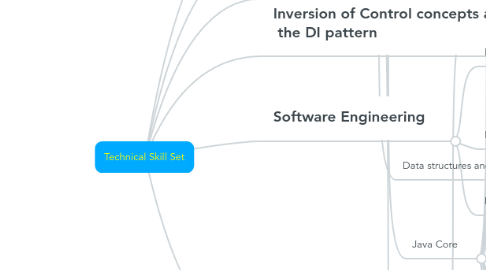
1. Advanced
1.1. UML
1.2. Web Services
1.2.1. REST
1.2.2. SOAP/WSDL
1.3. Software Design Patterns
1.3.1. Patterns
1.3.1.1. Creational Patterns
1.3.1.1.1. Singleton
1.3.1.1.2. Prototype
1.3.1.1.3. Builder
1.3.1.1.4. Factory
1.3.1.2. Behavioral Patterns
1.3.1.2.1. Observer
1.3.1.2.2. Strategy
1.3.1.3. Structural Patterns
1.3.1.3.1. Decorator
1.3.1.3.2. Proxy
1.3.1.3.3. Adapter
1.3.2. Design Principles
1.3.2.1. Single Responsibility Principle
1.3.2.2. Open/Close Principle
1.3.2.3. Liskov's Substitution Principle
1.3.2.4. Interface Segregation Principle
1.3.2.5. Dependency Inversion Principle
1.4. Data structures and Algorithms
2. Foundation
2.1. Version Control System (Git)
2.1.1. Compare code
2.1.2. Patch
2.1.3. Branching Model
2.1.4. Stash
2.1.5. Tag
2.1.6. Rebase/Merge
2.1.7. Commit/Pull/Push
2.1.8. Branching
2.1.9. Untitled
2.1.10. Repository
2.2. Logging
2.2.1. Logging concepts
2.2.2. Logging frameworks
2.2.2.1. Log4J
2.2.2.2. SLF4J
2.2.2.3. Logback
2.3. Testing
2.3.1. Common Testing concepts
2.3.2. Load, Stress test tool
2.3.2.1. SOAP UI
2.3.2.2. Jmeter
2.3.3. Unit test
2.3.3.1. Junit
2.3.3.2. Mocking library
2.3.3.2.1. Mockito
2.3.3.2.2. PowerMock
2.3.4. Automation test
2.3.4.1. Selenium
2.3.4.2. Robonium
2.4. Clean Code
2.5. NoSQL
2.6. SQL
2.7. Java Script
2.7.1. Server-side JS
2.7.1.1. NodeJS
2.7.2. Client-side JS
2.7.2.1. Storage
2.7.2.1.1. localStorage
2.7.2.1.2. sessionStorage
2.7.2.1.3. Cookies
2.7.2.2. jQuery
2.7.2.3. Event Handling
2.7.2.4. Scripting CSS
2.7.2.5. DOM manipulations
2.7.2.6. the "window" object
2.7.2.7. Embedding JS in HTML
2.7.3. Core JS
2.7.3.1. Classes and modules
2.7.3.1.1. Classes
2.7.3.1.2. Prototype
2.7.3.1.3. Constructors
2.7.3.1.4. OOP in JS
2.7.3.1.5. Modules
2.7.3.2. Funtions
2.7.3.2.1. Funtional programming
2.7.3.2.2. Funtion properties, methods, constructor
2.7.3.2.3. Closures
2.7.3.2.4. Defining & Invoking Functions
2.7.3.3. Arrays
2.7.3.4. Objects in JS
2.7.3.4.1. Object serialization
2.7.3.4.2. Properties getter and setter
2.7.3.4.3. Enumerating properties
2.7.3.4.4. Deleting properties
2.7.3.4.5. Querying and setting properties
2.7.3.4.6. Creating Objects
2.7.3.5. Statements
2.7.3.5.1. Expression statements
2.7.3.5.2. Compound statements
2.7.3.5.3. Conditional statements
2.7.3.5.4. Loops
2.7.3.6. Expression & Operators
2.7.3.7. JS Types, Value & Variables
2.7.3.7.1. Numbers
2.7.3.7.2. Text
2.7.3.7.3. Boolean Values
2.7.3.7.4. null vs undefined
2.7.3.7.5. the Global Object
2.7.3.7.6. Wrapper Objects
2.7.3.7.7. Immutable Primitive & Mutable Object Reference
2.7.3.7.8. Type Conversions
2.7.3.7.9. Variable Declaration
2.7.3.7.10. Variable Scope & Hoisting
2.8. HTML & CSS
2.8.1. HTML
2.8.2. CSS
2.9. JSP / Servlets
2.9.1. Web Application Container (Tomcat)
2.9.2. MVC Architecture
2.9.3. HTTP
2.9.4. Cookies & Session
2.9.5. Deployment Descriptor
2.9.6. Servlets
2.9.7. Servlet Filters
2.9.8. JSP
2.10. Java Core
2.10.1. Declarations and Access Control
2.10.1.1. Classes
2.10.1.2. Interfaces
2.10.1.3. Enums
2.10.1.4. Access/Non-Access modifiers
2.10.2. Object-Oriented in Java
2.10.2.1. Encapsulation
2.10.2.2. Inheritance
2.10.2.3. Polymorphism
2.10.2.4. Abstraction
2.10.2.5. Overriding/Overloading
2.10.2.6. Constructor
2.10.2.7. Coupling & Cohesion
2.10.3. Assignments
2.10.3.1. Variables
2.10.3.2. Passing variables
2.10.3.3. Array
2.10.3.4. Initialization blocks
2.10.3.5. Wrapper & Auto-Boxing
2.10.4. Operators
2.10.5. Flow control
2.10.6. Exceptions
2.10.6.1. Are checked exceptions
2.10.6.2. Exceptions in java
2.10.6.3. Designing with exceptions
2.10.6.4. Exceptional practices
2.10.7. String, StringBuffer, StringBuilder
2.10.8. Java I/O API
2.10.9. Serialization
2.10.10. Generics
2.10.10.1. http://tutorials.jenkov.com/java-generics/index.html
2.10.10.2. https://docs.oracle.com/javase/tutorial/java/generics/index.html
2.10.11. Java Collections API
2.10.12. Inner & Anonymous Classes
2.10.13. Concurrency In Java
2.10.13.1. Java Concurrency in Practice ebook
2.10.13.2. http://tutorials.jenkov.com/java-concurrency/index.html
2.10.13.3. http://www.vogella.com/tutorials/JavaConcurrency/article.html
2.10.14. Advanced
2.10.14.1. Reflection
2.10.14.1.1. http://tutorials.jenkov.com/java-reflection/index.html
2.10.14.1.2. https://www.javaworld.com/article/2077015/java-se/take-an-in-depth-look-at-the-java-reflection-api.html
2.10.14.2. Annotations
2.10.14.2.1. https://dzone.com/articles/how-annotations-work-java
2.10.14.2.2. http://tutorials.jenkov.com/java/annotations.html
2.10.14.2.3. https://docs.oracle.com/javase/tutorial/java/annotations/
2.10.14.3. Class loader
2.10.14.3.1. https://en.wikipedia.org/wiki/Classpath_(Java)
2.10.14.3.2. https://en.wikipedia.org/wiki/Java_Class_Library
2.10.14.3.3. http://javarevisited.blogspot.com/2012/12/how-classloader-works-in-java.html
2.10.14.3.4. https://www.journaldev.com/349/java-classloader
2.10.14.3.5. https://www.javaworld.com/article/2077260/learn-java/learn-java-the-basics-of-java-class-loaders.html
2.10.15. Memory management & Garbage collection
2.10.15.1. https://www.dynatrace.com/resources/ebooks/javabook/how-garbage-collection-works/
2.10.15.2. https://howtodoinjava.com/core-java/garbage-collection/revisiting-memory-management-and-garbage-collection-mechanisms-in-java/
2.10.15.3. https://dzone.com/articles/java-performance-tuning
2.11. Programming paradigms
2.11.1. Object-Oriented Programming (OOP)
2.11.2. Funtional Programming (FP)
2.11.3. Aspect-Oriented Programming (AOP)
3. JDBC Framework
4. Inversion of Control concepts and the DI pattern
5. Software Engineering
5.1. Processes
5.1.1. Agile/Scrum
5.1.2. Kanban
5.2. Practices
5.2.1. Continuous Integration (CI)
5.2.2. Continuous Delivery (CD)
5.2.3. DevOps
5.3. Design pattern
6. Frameworks & Tools
6.1. Spring & Hibernate
6.1.1. Spring Core
6.1.1.1. Web MVC
6.1.1.1.1. View Resolvers & Technologies
6.1.1.1.2. Spring Controllers
6.1.1.1.3. Spring MVC components
6.1.1.1.4. DispatcherServlet Request Processing Workflow
6.1.1.1.5. the MVC pattern
6.1.1.2. Configuration
6.1.1.2.1. XML-based Configuration
6.1.1.2.2. Annotation-based Configuration
6.1.1.3. Bean
6.1.1.3.1. Bean Injection
6.1.1.3.2. Bean Auto-wiring
6.1.1.3.3. Bean Life Cycle
6.1.1.3.4. Bean Scopes
6.1.1.3.5. Bean Definitions
6.1.1.4. Bean Factory
6.1.1.5. Application Context
6.1.1.5.1. Profiles
6.1.1.5.2. Scopes
6.1.1.5.3. Component-Scanning
6.1.1.5.4. Resource Loading
6.1.1.5.5. ContextLoaderListener & DispatcherServlet
6.1.1.6. the IoC Container
6.1.1.7. Spring Framework Architecture Overview
6.1.2. Spring Data JPA/Hibernate
6.1.2.1. Spring Data JPA
6.1.2.2. ORM concept
6.1.2.3. Spring Data JPA
6.1.3. Spring Boot
6.1.3.1. Convention over Configuration concept
6.1.3.2. @Conditional & Autoconfiguration
6.1.3.3. Spring Boot Starter Dependencies
6.1.3.4. Externalize configuration
6.1.3.5. Initializing a Spring Boot project with Spring Initializr
6.1.4. Spring Security
6.1.4.1. Spring Security Filter Chain
6.1.4.2. DelegatingFilterProxy & FilterChainProxy
6.1.4.3. SecurityContextHolder
6.1.4.4. Customize UserDetailsService
6.1.4.5. Custom AuthenticationProvider
6.1.4.6. Custom Authorization
6.2. Maven
6.2.1. POM
6.2.2. Dependencies
6.2.2.1. exclude
6.2.2.2. scope
6.2.2.3. show dependencies diagram
6.2.2.4. resolve conflict
6.2.2.5. Dependency Management
6.2.2.6. Effect priority
6.2.3. Build life cycle
6.2.4. Build profiles
6.2.5. Plug-ins
6.2.6. Repositories
6.2.7. Build & Test project
6.2.8. Archetype
6.3. Angular JS
6.3.1. Angular
6.3.2. W3School

